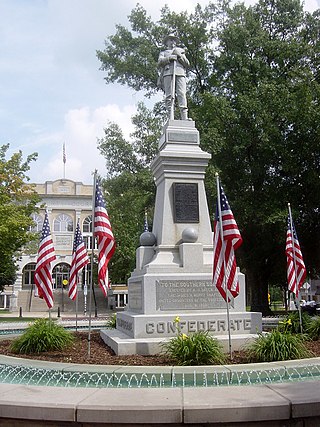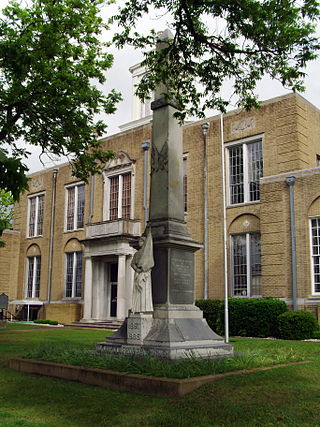
The Indiana State Soldiers and Sailors Monument is a 284 ft 6 in (86.72 m) tall neoclassical monument built on Monument Circle, a circular, brick-paved street that intersects Meridian and Market streets in the center of downtown Indianapolis, Indiana. In the years since its public dedication on May 15, 1902, the monument has become an iconic symbol of Indianapolis, the state capital of Indiana. It was added to the National Register of Historic Places on February 13, 1973 and was included in an expansion of the Indiana World War Memorial Plaza National Historic Landmark District in December 2016. It is located in the Washington Street-Monument Circle Historic District. It is also the largest outdoor memorial and the largest of its kind in Indiana.

Little Rock National Cemetery is a United States National Cemetery, located approximately two miles (3 km) south-east of the Arkansas State Capitol Building, being within the city of Little Rock, and Pulaski County, Arkansas. It encompasses 31.7 acres (12.8 ha), and as of the end of 2005, had 25,172 interments. Administered by the United States Department of Veterans Affairs, it is currently closed to new interments.

Camp Moore, north of the Village of Tangipahoa near Kentwood, Louisiana, was a Confederate training base and principal base of operations in eastern Louisiana and southwestern Mississippi. The base was named for Louisiana Governor Thomas Overton Moore. It operated from May 1861 to 1864 during the American Civil War. Confederate monuments were erected at the cemetery and on the grounds in the early 20th century.

The Civil War Memorial, in the DeKalb County county seat of Sycamore, Illinois, United States, is located in front of the DeKalb County Courthouse on a public square. The memorial was erected in 1896 and dedicated in 1897. The structure is a memorial to the thousands of DeKalb County residents who served in the American Civil War. It incorporates an obelisk which rises to 50 feet in height. The base is adorned with copper sculpture, completed by an unknown sculptor. On the east facade of the memorial the word "Antietam", denoting the Battle of Antietam, is misspelled. This work of public art underwent its first restoration work in 2005-2006.

The World War I Memorial is a bronze sculpture by Pietro Montana and is located at the intersection of Taunton Avenue, Whelden Avenue, and John Street in East Providence, Rhode Island, United States. The sculpture is modeled on Charles Atlas and depicts a dynamically posed soldier standing on a granite base. Montana's original design was modified by the East Providence Memorial Committee for being "too brutal". Dedicated on July 30, 1927, Major General Charles Pelot Summerall gave an address which highlighted the handicap placed upon the soldiers by a lack of preparedness and "invoked the fighting ideal embodied by Montana's doughboy." The World War I Memorial was added to the National Register of Historic Places in 2001.

Liberty Arming the Patriot, sometimes called Freedom Arming the Patriot, is a bronze sculpture at Park Place in Pawtucket, Rhode Island, commemorating the participation of the city's citizens in the American Civil War. It was designed by William Granville Hastings and cast by the Gorham Manufacturing Company in 1897. Unlike many Civil War memorials, Liberty Arming the Patriot is a dynamic composition, depicting a young farmer setting his plow aside, and reaching to take a sword from a classical female figure clad in breastplate and wielding a pike. The statue is 11 feet (3.4 m) in height, and is mounted on a granite base 10 feet (3.0 m) high and 22 feet (6.7 m) wide. The sculpture was listed on the National Register of Historic Places in 2001.

General Philip Sheridan is a bronze sculpture that honors Civil War general Philip Sheridan. The monument was sculpted by Gutzon Borglum, best known for his design of Mount Rushmore. Dedicated in 1908, dignitaries in attendance at the unveiling ceremony included President Theodore Roosevelt, members of the President's cabinet, high-ranking military officers and veterans from the Civil War and Spanish–American War. The equestrian statue is located in the center of Sheridan Circle in the Sheridan-Kalorama neighborhood of Washington, D.C. The bronze statue, surrounded by a plaza and park, is one of eighteen Civil War monuments in Washington, D.C., which were collectively listed on the National Register of Historic Places in 1978. The sculpture and surrounding park are owned and maintained by the National Park Service, a federal agency of the Interior Department.

The George Gordon Meade Memorial, also known as the Meade Memorial or Major General George Gordon Meade, is a public artwork in Washington, D.C. honoring George Meade, a career military officer from Pennsylvania who is best known for defeating General Robert E. Lee at the Battle of Gettysburg. The monument is sited on the 300 block of Pennsylvania Avenue NW in front of the E. Barrett Prettyman United States Courthouse. It was originally located at Union Square, but was removed and placed in storage for fourteen years before being installed at its current location. The statue was sculpted by Charles Grafly, an educator and founder of the National Sculpture Society, and was a gift from the state of Pennsylvania. Prominent attendees at the dedication ceremony in 1927 included President Calvin Coolidge, Governor John Stuchell Fisher, Secretary of the Treasury Andrew W. Mellon, and Senator Simeon D. Fess.

The Dupont Circle Fountain, formally known as the Rear Admiral Samuel Francis Dupont Memorial Fountain, is a fountain located in the center of Dupont Circle in Washington, D.C. It honors Rear Admiral Samuel Francis Du Pont, a prominent American naval officer and member of the Du Pont family. The fountain replaced a statue of Du Pont that was installed in 1884. Designed by Henry Bacon and sculpted by Daniel Chester French, the fountain was dedicated in 1921. Prominent guests at the dedication ceremony included First Lady Florence Harding, Secretary of War John W. Weeks and Secretary of the Navy Edwin Denby.

The Stephenson Grand Army of the Republic Memorial, also known as Dr. Benjamin F. Stephenson, is a public artwork in Washington, D.C. honoring Dr. Benjamin F. Stephenson, founder of the Grand Army of the Republic, a fraternal organization for Union veterans. The memorial is sited at Indiana Plaza, located at the intersection of 7th Street, Indiana Avenue, and Pennsylvania Avenue NW in the Penn Quarter neighborhood. The bronze figures were sculpted by J. Massey Rhind, a prominent 20th-century artist. Attendees at the 1909 dedication ceremony included President William Howard Taft, Senator William Warner, and hundreds of Union veterans.

The Bentonville Confederate Monument was installed in Bentonville, Arkansas, United States. It was removed in September 2020.

The Monticello Confederate Monument stands at the end of the main entrance road to the Oaklawn Cemetery in Monticello, Arkansas. It was dedicated in 1915 to the Confederate soldiers of Drew County who served in the American Civil War. The main sculpture, which is made of marble, depicts a uniformed Confederate soldier carrying a blanket roll, and wearing a scabbard. He stands with both hands on a rifle, whose butt end is on the ground. It measures 6 feet (1.8 m) tall and about 20 inches (51 cm) square, and stands on a marble base 20 feet (6.1 m) high. It is inscribed as follows:

The Camden Confederate Monument, also known as the Confederate Women's Memorial, is located on the grounds of the Ouachita County Courthouse in Camden, Arkansas. The sculpture, carved out of Italian marble, depicts a woman dressed in the period of the American Civil War, standing with her feet together, clutching a flagpole. The sculpture is mounted on a block of North Carolina granite, next to a tall obelisk. The statue is 5 feet (1.5 m) tall. The obelisk is inscribed on three sides, recognizing the valor of women in the Confederate cause, and the organizations that funded the memorial's construction. The memorial was erected in 1914 by the local chapters of the United Confederate Veterans and the United Daughters of the Confederacy.

The Robert E. Lee Monument is a U. D. C. memorial built to honor Lee County's Confederate veterans. The monument was carved by the McNeel Marble Co. It is located in Marianna, Arkansas, across from the Lee County Courthouse. Dedicated in 1910, it is one of several monuments built to honor Confederate soldiers. The structure is a local tourist attraction and, since 1996, has been listed in the National Register of Historic Places.

The Arkansas Confederate Soldiers Monument, also known as Defense of the Flag, is located on the east side of the Arkansas State Capitol grounds in Little Rock, just off 4th Street. It is a five-tiered marble structure, topped by a bronze statue of an angel standing on a sphere, and a bronze Confederate Army soldier on the front of its fourth tier. It was built in 1904–05, with funding from a variety of sources, including the state, primarily through the efforts of a consortium of Confederate memorial groups. Originally located prominently near the main eastern entrance to the capitol building, it was later moved to its present location on the northeast lawn.

The Pine Bluff Confederate Monument has long been located in front of the Jefferson County courthouse, at Barraque and Main Streets in Pine Bluff, Arkansas. It depicts a standing Confederate Army soldier, holding a rifle whose butt rests on the ground. The statue, built out of Georgia marble by the McNeel Marble Company, stands on a stone base 15 feet (4.6 m) in height and 10 by 10 feet at the base. It was placed in 1910 by the local chapter of the United Daughters of the Confederacy.

The Little Rock Confederate Memorial is a stone memorial marker in Little Rock National Cemetery, Little Rock, Arkansas. Set in an overflow area of the cemetery on 21st and Barber Streets, it is a granite obelisk, mounted in a concrete base, measuring 18 feet (5.5 m) in height and a square base 67 inches (1.7 m) per side. Midway up the west side of the obelisk "U.D.C." is inscribed, with "1913" at the base of that side. Inscriptions on the sides of the base commemorate fallen Confederate Army soldiers. It was placed in 1913, paid for by the local chapter of the United Daughters of the Confederacy. The ceremony marked the first time that the federal government formally took charge of a former Confederate military cemetery.

The Memorial to Company A, Capitol Guards was an American Civil War memorial in MacArthur Park, Little Rock, Arkansas. It stood just northeast of the former Tower Building of the Little Rock Arsenal, at a junction of two of the park's internal roadways. It consisted of a bronze sculpture depicting a Confederate Army soldier in a defensive stance, holding a rifle pointed forward. The statue was 8 feet (2.4 m) in height, and was mounted in a granite column 16 feet (4.9 m) tall. The memorial was sometimes known as "Lest we forget", a line that appeared near the top of the inscription on the base. The statue was created by sculptor Rudolph Schwarz, and was installed in 1911; it was paid for by the local chapter of the Sons of Confederate Veterans, and memorializes the unit that seized the arsenal at the outset of the war.

The Monument to Confederate Women, also known as the "Mother of the South", is a commemorative sculpture on the grounds of the Arkansas State Capitol in Little Rock, Arkansas. It depicts a mother and two of her children saying goodbye to an older son who is dressed in a Confederate uniform. The sculpture is cast in bronze, and stands over 7 feet (2.1 m) in height. It is mounted in a multi-tiered pedestal, nearly 12 feet (3.7 m) in height, with sections made of concrete, granite, and marble. The statue was created by J. Otto Schweizer, and was dedicated in 1913. It was funded by the United Confederate Veterans.





















